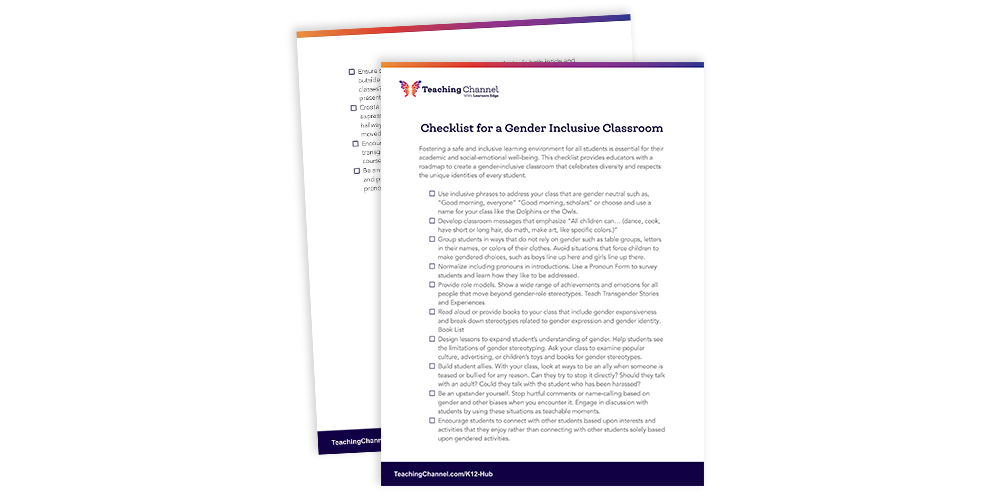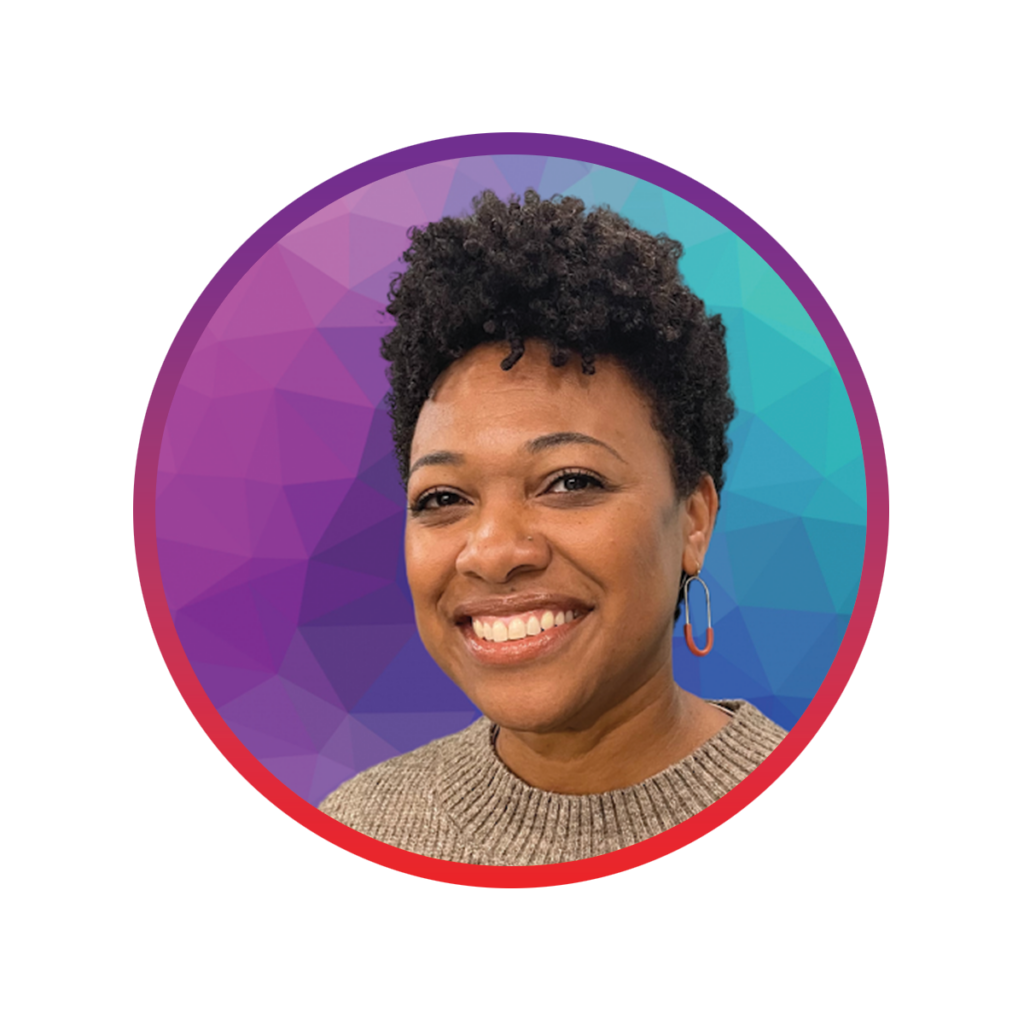Teachers work to support the academic and social-emotional wellbeing of students in classrooms, no matter their background, race, ethnicity, socio-economic status, religion, or gender expression. On any given day we are counselors, cheerleaders, learning facilitators, coaches, mentors, and more. Support is essential to the mental health of our students, and more acutely for our trans and gender-nonconforming young people. In fact, several studies have shown that trans and nonbinary kids are at a high risk for developing depression, anxiety, substance abuse, and even attempting suicide when they are not in a gender-affirming school environment. And kids 13–17 are at a higher risk than older teens and college-aged kids.
With these alarming facts and figures, it’s important to ensure educators have the knowledge and skills needed to better support their trans and gender-nonconforming students. Below we share 5 ways you can create a safer, more supportive learning space for trans and gender nonconforming students in your school.
1. Learn to use and respect pronouns.
A pronoun is a word that is used instead of a noun to refer to someone. Some examples of pronouns include:
- She, her, her, hers, and herself
- He, him, his, his, and himself
- They, them, their, theirs, and themself
- Ze/zie, hir, hir, hirs, and hirself
- Xe, xem, xyr, xyrs, and xemself
We can’t assume someone’s pronouns in the same way we can’t assume people’s gender identities or names, so it’s best to introduce yourself with your pronouns. This gives students the opportunity to share theirs and normalizes the usage of correct pronouns in the classroom. And, remember, mistakes happen! If you misgender someone, correct your mistake (or if they correct you, say ‘thank you’) and move on. Learn more about the appropriate use of pronouns —> Pronouns: A Resource for Educators
2. Educate yourself.
It can be an additional burden for trans and gender nonconforming youth to educate others, answering questions and being subjected to curiosity. Rather than rely on those students to provide the information you’re seeking, take the initiative to educate yourself. It’s ok to admit you don’t understand or know the right terminology. Part of being a good ally is continuing to learn and grow! The resources below are a great place to start, but also check out organizations in your local area for events and learning opportunities.
- The Trevor Project: https://www.thetrevorproject.org/
- GLSEN: https://www.glsen.org/
- National Center for Transgender Equality: https://transequality.org/
3. Teach an inclusive and affirming curriculum.
One way that educators can promote welcoming and inclusive school environments is by evaluating lessons to avoid bias and ensure the inclusion of positive representations of lesbian, gay, bisexual, transgender, and queer (LGBTQ) people, history, and events. An inclusive curriculum serves as a window, so that others can learn about the lived experiences of those that are different from themselves. This, in turn, builds empathy. A curriculum that includes the experiences, history, and events of the LGBTQ+ community can also act as a mirror for students who identify, helping to validate and affirm their experiences. Here are some tips to guide your curriculum development:
- Audit your curriculum– Review your existing lessons for LGBTQ+ representation.
- Identify gaps & opportunities– Look for places to deepen understanding of diverse identities.
- Weave it in– Integrate LGBTQ+ history, figures, and events across subjects.
- SEL connection– Teach about identity (including gender) as a part of your social emotional learning lessons.
- Student reflection– Use curriculum that encourages students to reflect on their own identities (including gender expression and family diversity).
| Download our Teaching Channel lesson plan on Transgender Stories and Experiences (grades 5-12) to celebrate the joy, courage, and resilience of the trans community. |
4. Be responsive to anti-LGBTQ language and behavior.
Be proactive in shifting school culture to be more affirming of trans people. You can start with a school-wide day of action and visibility, such as GLSEN’s Solidarity Week (November), Trans Day of Visibility (March), and the Day of No Silence (April). Additionally, you will want to work on creating a safer classroom environment by interrupting anti-LGBTQ comments. GLSEN suggests the steps below for addressing anti-LGBTQ language and behavior:
- Address Name-Calling, Bullying or Harassment Immediately. Concentrate on stopping the behavior in the moment. Sometimes it’s a simple response to hearing a derogatory term like, “That language is unacceptable in this classroom.” Remember: no action is an action.
- Name the Behavior. Describe what you saw and label the behavior. “That word is derogatory and is considered name-calling. That language is unacceptable.”
- Use the Teachable Moment (or Create One). Make sure to educate after stopping the behavior. Decide if you are going to educate in the moment or later, and if it will be publicly or privately. If you decide to educate later you will need to create the teachable moment. You can then take this opportunity to teach one class, the entire grade, or the whole school about language and behaviors that are acceptable and those that are not.
- Support the Targeted Student. Support the student who has been the target of name-calling, bullying, or harassment. Do not make assumptions about what the student is experiencing. Ask the student what they need or want. You will have to decide whether to do this in the moment or later, and if it will be publicly or privately.
- Hold Students Accountable. Check school policy and impose appropriate consequences. Make sure disciplinary actions are evenly applied across all types of name-calling, bullying and harassment.
5. Use your privilege to advocate for, amplify, and center the voices of those in the trans/gender non-conforming community.
Educators hold a unique position of authority and trust within their classrooms. Leverage this privilege to act as an advocate for transgender and gender nonconforming students. By actively seeking out resources and integrating them into lessons, you can amplify the voices and experiences of trans individuals. You may also start conversations with colleagues about updating school policies to be gender-inclusive or work with the leaders to implement preferred name and pronoun practices. This Policy Checkup document from Learning for Justice provides a comprehensive list of inclusive policies along with examples.
By sharing resources and personal experiences on the positive impact of inclusivity, educators can inspire school-wide changes that benefit all students. Ultimately, this advocacy can create a ripple effect, fostering a more welcoming and supportive environment for transgender and gender nonconforming students throughout the entire school building.
Creating a classroom where all students feel valued and respected requires ongoing effort. Download our Gender Inclusive Classroom checklist to take actionable steps towards building a gender-inclusive learning environment where students can thrive!

Prefer to work digitally? This checklist is also available as a Google Doc!
About the Author

Marcee Harris is the Director of Curriculum and Instruction at Teaching Channel. She holds a B.A. in Elementary Education and Sociology, as well as an M.A. Ed. in Education. Marcee specializes in curriculum development, maintaining and updating our course catalog, and partners with her Teaching Channel teammates to ensure customer success. Marcee is our resident expert for everything related to EdTech and the Science of Reading.
Fun Fact: Marcee used to be a professional cheerleader!






